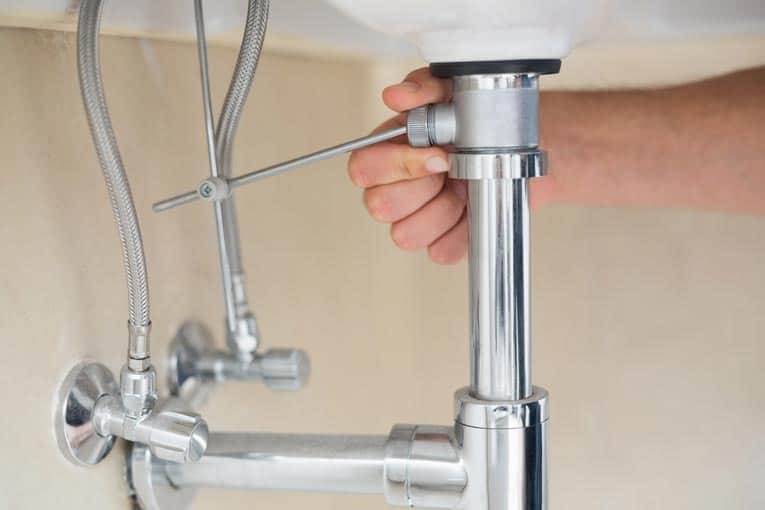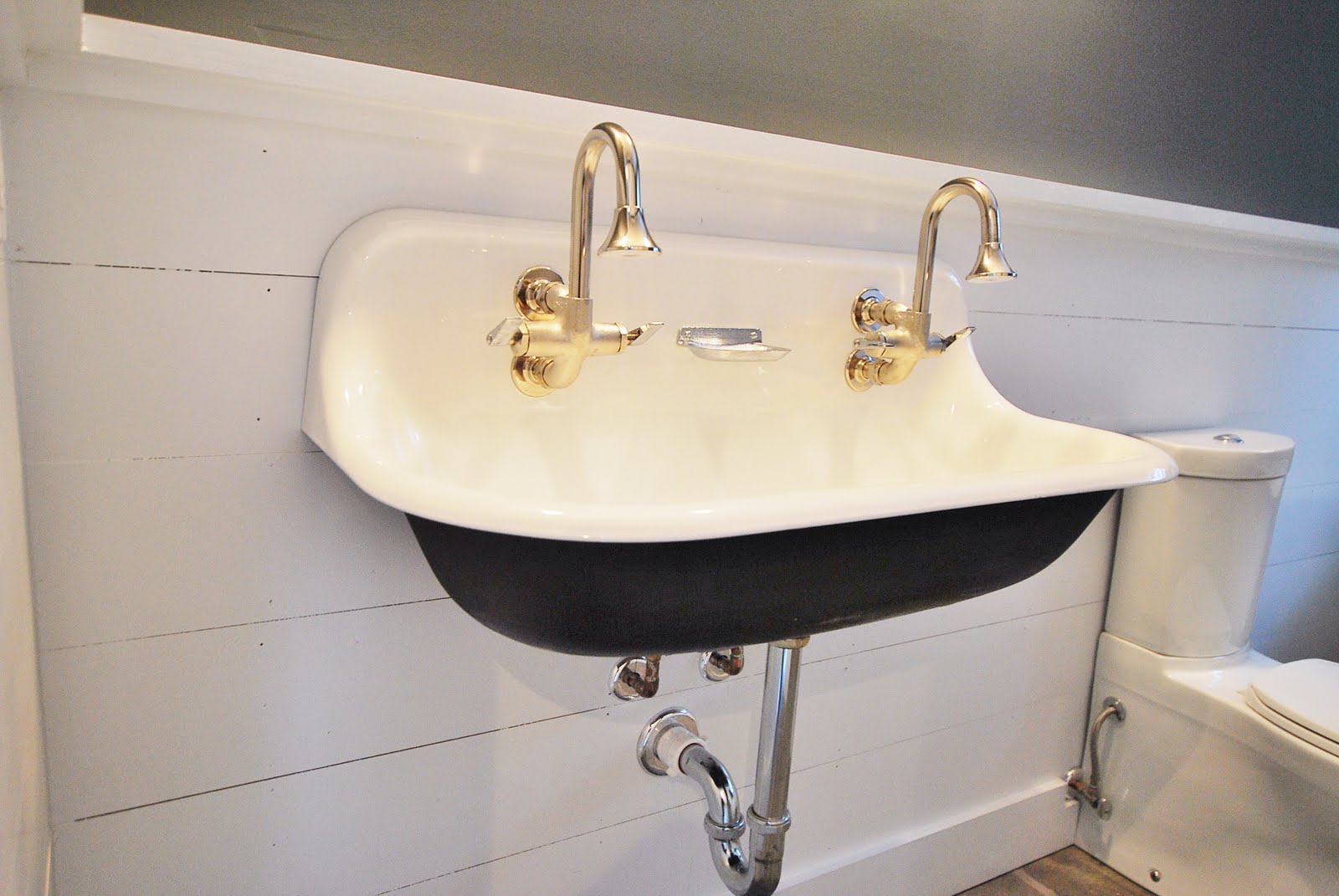When it comes to bathroom sinks, the P-trap is a classic and reliable choice. This type of trap gets its name from its shape, resembling the letter "P". It is a curved pipe that connects the drain of the sink to the plumbing system, effectively trapping water in the bend and preventing sewer gases from entering your bathroom. P-traps are usually made of PVC or ABS plastic and are easy to install and maintain. One of the main advantages of a P-trap is its versatility. It can be used with most types of bathroom sinks, including top-mount, undermount, and vessel sinks. It also comes in various sizes to fit different drain openings. Additionally, P-traps are affordable and readily available at most home improvement stores. Overall, if you want a simple and efficient trap for your bathroom sink, a P-trap is a solid choice. P-trap for bathroom sinks
Similar to the P-trap, the S-trap is another traditional option for bathroom sinks. The only difference is the shape of the trap, which resembles the letter "S". This type of trap is commonly used in older homes, but it is becoming less popular due to its limitations. Unlike the P-trap, the S-trap can only be used with floor-mounted sinks and isn't suitable for wall-mounted or undermount sinks. Furthermore, S-traps are prone to siphoning, which can lead to unpleasant odors in your bathroom. To prevent this, an air admittance valve (AAV) must be installed, adding to the overall cost and complexity of the trap. While S-traps may still be a viable option for some bathroom setups, it is not recommended for modern plumbing systems. S-trap for bathroom sinks
A bottle trap is a stylish and modern alternative to traditional P-traps. As the name suggests, it is shaped like a bottle and is designed to be exposed under the sink. This type of trap is usually made of metal, such as brass or chrome, making it a more aesthetically pleasing option for those who want to showcase their bathroom's design. Bottle traps are also easy to install and maintain. They have a removable bottom, allowing for easy access to remove any debris that may accumulate over time. However, one drawback of bottle traps is their higher cost compared to other traps. They also have a smaller capacity for holding water, which may lead to more frequent clogs. But if you prioritize style and have a smaller sink, a bottle trap can be a great choice for your bathroom. Bottle trap for bathroom sinks
An adjustable trap, also known as a telescopic trap, is a versatile option that can be adjusted in length to fit different sink and drain configurations. This type of trap is useful when installing a new sink or making changes to your plumbing system since it can accommodate variations in distance and angles. Adjustable traps are typically made of PVC or ABS plastic and are budget-friendly. They are also easy to install and maintain, making them a practical choice for DIY enthusiasts. However, adjustable traps may not have the same durability as other traps and may need to be replaced more frequently. Adjustable trap for bathroom sinks
A pop-up trap, also known as a clicker drain, is a trap that has a built-in stopper mechanism. This allows you to open and close the drain by simply pressing down on the stopper. Pop-up traps are commonly used in modern bathroom sinks because they eliminate the need for a separate drain plug, creating a sleek and seamless look. While pop-up traps may be more expensive than other traps, they offer convenience and ease of use. They are also available in different finishes, allowing you to match them with your faucet and other bathroom fixtures. However, one drawback is that pop-up traps can be challenging to clean, as hair and debris can get caught in the mechanism. Pop-up trap for bathroom sinks
If you have a sink that is not in a standard position, a flexible trap may be the solution. As the name suggests, this type of trap is made of flexible material, usually PVC or rubber, that can be bent and shaped to fit various drain configurations. Flexible traps are ideal for unconventional sink installations, such as corner sinks or sinks with offset drains. One of the main advantages of a flexible trap is its versatility and ability to adapt to different situations. They are also relatively easy to install and affordable. However, the flexibility of the material may also make the trap prone to leaks and damage. It is essential to check for any signs of wear and tear regularly and replace the trap if necessary. Flexible trap for bathroom sinks
For a minimalist and modern look, a wall-mounted trap may be the perfect choice for your bathroom sink. This type of trap is installed directly into the wall, usually behind the sink, creating a seamless and clean appearance. It is commonly used with wall-mounted or pedestal sinks, where there is no vanity or cabinet to conceal the trap. Wall-mounted traps come in various styles and finishes, allowing you to choose a design that complements your bathroom's aesthetic. They also free up space under the sink, making it easier to clean and maintain. However, wall-mounted traps may be more challenging to install, as they require a precise and secure connection to the wall's plumbing. Wall-mounted trap for bathroom sinks
An undermount trap is a type of trap designed specifically for undermount sinks, where the sink is mounted underneath the counter, creating a seamless and streamlined look. This type of trap is typically made of a transparent material, such as PVC or acrylic, to make it less visible and blend in with the sink. One of the main advantages of an undermount trap is its aesthetic appeal. It allows for a cleaner and more modern look in the bathroom, as there is no visible trap under the sink. However, undermount traps may be more challenging to install and may require the help of a professional. They are also more expensive than traditional traps. Undermount trap for bathroom sinks
If you want to make a statement with your bathroom sink, a decorative trap may be the way to go. This type of trap is designed with aesthetics in mind and comes in various styles, shapes, and finishes. From intricate designs to bold colors, a decorative trap can add a touch of personality to your bathroom. Aside from its visual appeal, a decorative trap functions just like any other trap, effectively preventing sewer gases from entering your bathroom. They are typically made of metal and may be more expensive than standard traps. Additionally, some decorative traps may be more challenging to install, requiring the help of a professional plumber. Decorative trap for bathroom sinks
A low-profile trap, also known as a slim-line trap, is a type of trap designed to save space under your sink. This type of trap is commonly used in bathrooms with limited space, such as small powder rooms or half baths. It is typically slimmer and shorter than a standard trap, allowing for more room under the sink for storage or cleaning. One of the main advantages of a low-profile trap is its space-saving design. It is also relatively easy to install and maintain, and it comes in various materials and finishes to match your sink and faucet. However, low-profile traps may have a smaller capacity for holding water, which can lead to more frequent clogs. It is also essential to ensure that the trap is correctly installed to prevent any leaks. Overall, there are many trap options available for your bathroom sink, each with its advantages and limitations. It is essential to consider your sink's design, the size of your bathroom, and your budget when choosing the right trap. With the right trap, you can ensure a functional and visually appealing bathroom sink for years to come. Low-profile trap for bathroom sinks
How to Avoid Common Bathroom Sink Traps for a Functional and Stylish Design

Importance of a Well-Designed Bathroom Sink
 A bathroom sink is an essential part of any household, used for daily hygiene tasks such as brushing teeth, washing hands, and applying skincare products. It is also a significant design element in a bathroom, adding style and personality to the space. However, having a poorly designed sink can lead to frustrating and costly issues. One common problem that homeowners face is falling into traps for bathroom sinks. These traps can cause problems with functionality, aesthetics, and even lead to water damage. In this article, we will discuss how to avoid these traps and create a functional and stylish bathroom sink design for your home.
A bathroom sink is an essential part of any household, used for daily hygiene tasks such as brushing teeth, washing hands, and applying skincare products. It is also a significant design element in a bathroom, adding style and personality to the space. However, having a poorly designed sink can lead to frustrating and costly issues. One common problem that homeowners face is falling into traps for bathroom sinks. These traps can cause problems with functionality, aesthetics, and even lead to water damage. In this article, we will discuss how to avoid these traps and create a functional and stylish bathroom sink design for your home.
Understanding the Different Types of Traps for Bathroom Sinks
 Before we dive into how to avoid traps, it's essential to understand what they are and how they work. A trap is a curved or S-shaped pipe under the sink that prevents sewer gases from entering the bathroom and also traps debris to prevent clogging. There are several types of traps available, such as P-traps, S-traps, and bottle traps. Each trap has its own advantages and disadvantages, and it's crucial to choose the right one for your specific bathroom sink design.
Before we dive into how to avoid traps, it's essential to understand what they are and how they work. A trap is a curved or S-shaped pipe under the sink that prevents sewer gases from entering the bathroom and also traps debris to prevent clogging. There are several types of traps available, such as P-traps, S-traps, and bottle traps. Each trap has its own advantages and disadvantages, and it's crucial to choose the right one for your specific bathroom sink design.
The Dangers of Falling into Bathroom Sink Traps
 One of the most common traps that homeowners fall into is choosing a trap solely for its aesthetics, without considering its functionality. For example, a bottle trap may look sleek and modern, but it may not provide enough space for a garbage disposal unit. This can lead to clogs and expensive repairs. Another trap to watch out for is choosing a shallow trap to save space, which can easily get clogged and cause water to back up into the sink. Additionally, a poorly designed trap can also lead to leaks and water damage, which can be costly to fix.
One of the most common traps that homeowners fall into is choosing a trap solely for its aesthetics, without considering its functionality. For example, a bottle trap may look sleek and modern, but it may not provide enough space for a garbage disposal unit. This can lead to clogs and expensive repairs. Another trap to watch out for is choosing a shallow trap to save space, which can easily get clogged and cause water to back up into the sink. Additionally, a poorly designed trap can also lead to leaks and water damage, which can be costly to fix.
Tips for Avoiding Bathroom Sink Traps
 The key to avoiding traps for bathroom sinks is to carefully plan and research before making any decisions. Start by assessing your bathroom's layout and plumbing to determine which trap will work best for your sink. Consider the size of your sink and its location in the bathroom when choosing a trap. You should also consult with a professional plumber to ensure that the trap you choose will function correctly and meet local building codes. Lastly, don't sacrifice functionality for aesthetics. There are many stylish trap options available that also provide efficient functionality.
The key to avoiding traps for bathroom sinks is to carefully plan and research before making any decisions. Start by assessing your bathroom's layout and plumbing to determine which trap will work best for your sink. Consider the size of your sink and its location in the bathroom when choosing a trap. You should also consult with a professional plumber to ensure that the trap you choose will function correctly and meet local building codes. Lastly, don't sacrifice functionality for aesthetics. There are many stylish trap options available that also provide efficient functionality.
In Conclusion
 In conclusion, a well-designed bathroom sink is essential for both functionality and style. Avoiding common traps for bathroom sinks is crucial to prevent issues such as clogging, leaks, and water damage. Remember to carefully consider the type of trap you choose, consult with professionals, and prioritize functionality over aesthetics. By following these tips, you can create a beautiful and functional bathroom sink design that will last for years to come.
In conclusion, a well-designed bathroom sink is essential for both functionality and style. Avoiding common traps for bathroom sinks is crucial to prevent issues such as clogging, leaks, and water damage. Remember to carefully consider the type of trap you choose, consult with professionals, and prioritize functionality over aesthetics. By following these tips, you can create a beautiful and functional bathroom sink design that will last for years to come.











/sink-drain-trap-185105402-5797c5f13df78ceb869154b5.jpg)













































/sink-drain-trap-185105402-5797c5f13df78ceb869154b5.jpg)






























